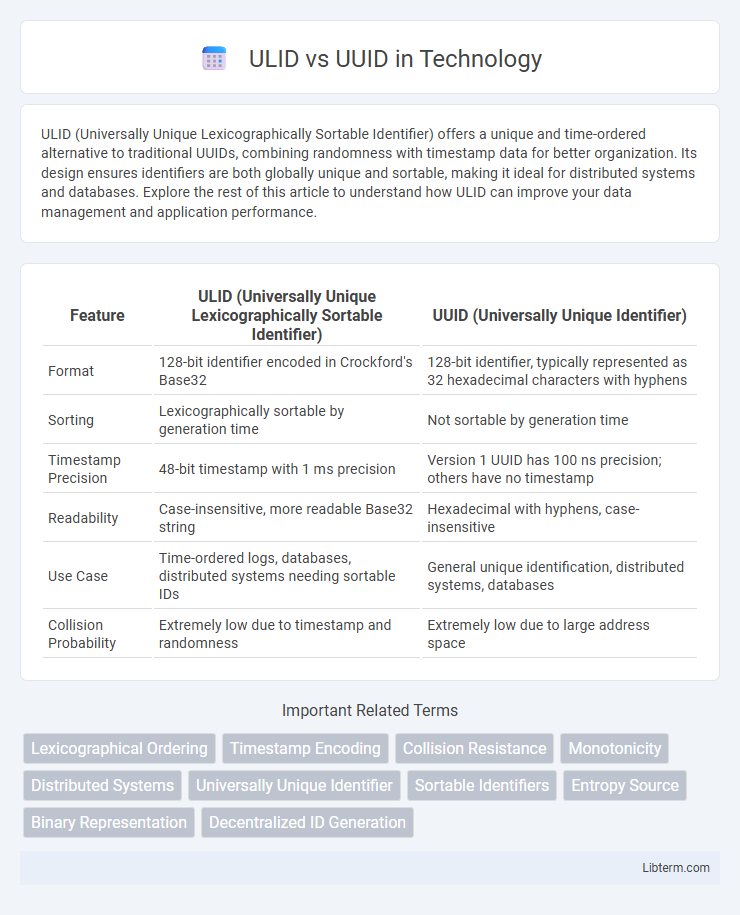ULID (Universally Unique Lexicographically Sortable Identifier) offers a unique and time-ordered alternative to traditional UUIDs, combining randomness with timestamp data for better organization. Its design ensures identifiers are both globally unique and sortable, making it ideal for distributed systems and databases. Explore the rest of this article to understand how ULID can improve your data management and application performance.
Table of Comparison
| Feature | ULID (Universally Unique Lexicographically Sortable Identifier) | UUID (Universally Unique Identifier) |
|---|---|---|
| Format | 128-bit identifier encoded in Crockford's Base32 | 128-bit identifier, typically represented as 32 hexadecimal characters with hyphens |
| Sorting | Lexicographically sortable by generation time | Not sortable by generation time |
| Timestamp Precision | 48-bit timestamp with 1 ms precision | Version 1 UUID has 100 ns precision; others have no timestamp |
| Readability | Case-insensitive, more readable Base32 string | Hexadecimal with hyphens, case-insensitive |
| Use Case | Time-ordered logs, databases, distributed systems needing sortable IDs | General unique identification, distributed systems, databases |
| Collision Probability | Extremely low due to timestamp and randomness | Extremely low due to large address space |
Introduction to ULID and UUID
ULID (Universally Unique Lexicographically Sortable Identifier) and UUID (Universally Unique Identifier) are both designed to generate unique identifiers for distributed systems and databases. ULID offers time-ordered, lexicographically sortable 128-bit identifiers, improving indexing and query efficiency in comparison to UUID's random or version-based 128-bit identifiers. While UUID version 4 relies on random generation, ULID combines timestamp precision with randomness, making ULID especially advantageous for distributed applications requiring both uniqueness and temporal sorting.
What is a UUID?
A UUID (Universally Unique Identifier) is a 128-bit number used to uniquely identify information in computer systems, ensuring global uniqueness across different devices and networks. Commonly formatted as 32 hexadecimal digits displayed in five groups separated by hyphens, UUIDs are widely used in databases, software development, and distributed systems to avoid identifier collisions. Their standardization by the IETF (RFC 4122) supports multiple versions, including time-based and random UUIDs, balancing uniqueness and generation efficiency.
What is a ULID?
A ULID (Universally Unique Lexicographically Sortable Identifier) is a 128-bit identifier designed to be universally unique and sortable by generation time, unlike the standard UUID which is purely random or time-based but not lexicographically ordered. ULIDs encode a 48-bit timestamp with millisecond precision followed by an 80-bit randomness component, enabling efficient chronological sorting and uniqueness even across distributed systems. This makes ULIDs ideal for databases, distributed logging, and event sourcing where ordered and unique identifiers are essential.
Key Differences Between ULID and UUID
ULID (Universally Unique Lexicographically Sortable Identifier) offers lexicographical sorting based on timestamp, enabling efficient database indexing and query performance compared to UUID (Universally Unique Identifier), which lacks inherent sortability. ULIDs are 128-bit identifiers encoded in Base32, producing more compact and URL-friendly strings than the hexadecimal UUID format. Moreover, ULIDs combine time and randomness for global uniqueness, while UUIDs rely on various versions with differing randomness and timestamp usage, affecting collision probability and ordering capabilities.
Structure and Format Comparison
ULID (Universally Unique Lexicographically Sortable Identifier) features a 128-bit structure divided into a 48-bit timestamp and an 80-bit random component, enabling chronological sorting and high uniqueness. UUID (Universally Unique Identifier) also contains 128 bits but is structured into fields like time-low, time-mid, time-high, clock sequence, and node, with variants such as UUIDv1 and UUIDv4 differing in timestamp and randomness. ULID uses Crockford's Base32 encoding for a compact, case-insensitive 26-character string, whereas UUID employs hexadecimal representation separated by hyphens into a 36-character string, impacting readability and sorting behavior.
Performance and Efficiency
ULIDs offer superior performance and efficiency compared to UUIDs due to their lexicographically sortable structure, which enhances database indexing and query speed. Their 128-bit size matches that of UUIDs, but ULIDs generate time-based, collision-resistant identifiers with better compression and faster parsing in distributed systems. This makes ULIDs especially advantageous for high-throughput applications where chronological order and reduced storage overhead are critical.
Sorting and Indexing Capabilities
ULIDs provide better sorting and indexing capabilities compared to UUIDs because they are lexicographically sortable due to their time-based component, allowing for efficient chronological ordering in databases. UUIDs, especially version 4, are random and lack inherent ordering, which can lead to fragmented indexes and slower query performance. Databases benefit from ULIDs as their monotonic nature reduces write amplification and improves index locality, optimizing range queries and overall storage efficiency.
Use Cases: When to Use ULID or UUID
ULIDs provide better performance in distributed systems requiring ordered unique identifiers, making them ideal for databases and event sourcing where sorting by creation time is crucial. UUIDs, particularly version 4, are widely adopted for general-purpose unique identification due to their randomness and ease of generation across different platforms. ULIDs are preferable in scenarios demanding lexicographical sortability and approximate timestamp encoding, while UUIDs remain suitable for legacy systems and applications prioritizing collision resistance without ordering.
Security and Collision Risks
ULIDs (Universally Unique Lexicographically Sortable Identifiers) offer improved collision resistance compared to UUIDs (Universally Unique Identifiers) due to their 128-bit length combined with millisecond timestamp precision, significantly reducing the probability of duplicates in distributed systems. Both ULIDs and UUIDs provide adequate security for identifying resources, but UUIDv4 relies on random number generation, which can be vulnerable to weak entropy sources, whereas ULIDs use a timestamp component that can expose generation time, posing a potential privacy concern. Cryptographic security should not depend solely on ULID or UUID alone; secure implementations must incorporate strong random number generators and handle identifier exposure carefully to mitigate collision and security risks.
Conclusion: Choosing Between ULID and UUID
Choosing between ULID and UUID depends on application requirements such as uniqueness, sortability, and readability. ULIDs offer time-ordered identifiers with better lexicographical sorting and are more compact, making them ideal for distributed systems requiring ordered data. UUIDs provide widespread compatibility and established standards across platforms, suitable for general-purpose unique identification without inherent ordering needs.
ULID Infographic

 libterm.com
libterm.com